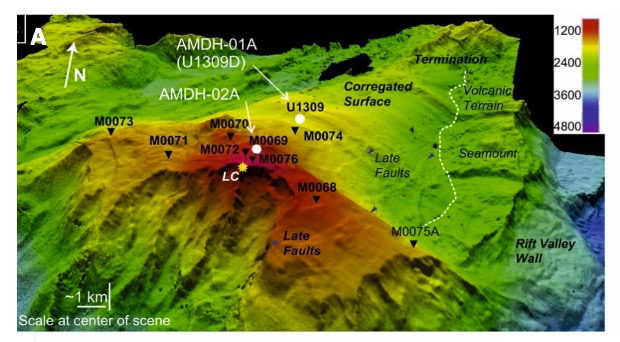航海概要
| 航海名 | Expedition 399: Building Blocks of Life, Atlantis Massif |
| プロポーザル/ Scientific Prospectus | ・プロポーザル #937-Full2, #937-Add ・Scientific Prospectus |
| 共同首席研究者 | Andrew McCaig and Susan Lang |
| 掘削船 | JOIDES Resolution |
| 航海期間 | 2023年4月12日~6月12日 |
| 乗船/下船地 | Ponta Delgada to Ponta Delgada, Portugal |
| JRSOのページ | https://iodp.tamu.edu/scienceops/expeditions/atlantis_massif_blocks_of_life.html |
| 掘削地点 |  |
| 科学目的 | 大西洋中央海嶺に位置するアトランティス岩体は、マントル物質であるカンラン岩を含むマフィック岩、超マフィック岩が断層運動によって海底に露出していることが確認されており、これまでにIODP第304次、305次、340T次、357次航海にて掘削が行われています。今回は、過去の4回の掘削点からさらに範囲を広げ、より深部への掘削を行い、海洋リソスフェアの相互作用、海洋化学、地下生物圏への複合的な影響について理解を深めます。 本航海の主要な科学目的は以下のとおりです。 1.火成作用、変成作用、構造地質、および流体の流れのプロセス間の相互作用を含む、海洋コアコンプレックスのライフサイクルの特徴を探る。 2.高温や低温下でのプレバイオティックな有機分子の形成など、地球上に生命が誕生する前の化学的プロセスを調べる。 3.深部生物圏の範囲と生命の限界を、岩相基質、多孔性と浸透性、温度、流体化学、反応性勾配にどのように影響されるかを含めて特定する。 The Atlantis Massif (AM) Oceanic Core Complex (30°N, Mid-Atlantic Ridge) is one of the earliest sites recognized for the extensive exposure of ultramafic and mafic rocks at the seafloor caused by an oceanic detachment fault, and has been the focus of four IODP expeditions (304, 305, 340T, and 357). The Lost City Hydrothermal Field (LCHF) is hosted in peridotite on its southern wall and vents alkaline fluids rich in H2 as a by-product of serpentinization. The AM is therefore an ideal natural laboratory for studying tectonics, magmatism, and the interaction between the ocean and lithosphere, as well as their combined influence on ocean chemistry and the subseafloor biosphere. Expedition 399 has three main scientific objectives: Characterizing the life-cycle of an oceanic core complex, including links among igneous, metamorphic, structural, and fluid flow processes. Accessing the chemical kitchen preceding the appearance of life on Earth, including the formation of organic molecules of prebiotic interest at high and low temperatures. Identifying the extent of the deep biosphere and limits for life, including how they are influenced by lithological substrate, porosity and permeability, temperature, fluid chemistry, and reactive gradients. A principle aim of the expedition is to sample fluids and rocks in a stable regime where active serpentinization may be occurring, creating the conditions where the building blocks for life (H2, CH4, and more complex organic compounds form abiotically. IODP Hole U1309D, located 5 km north of the LCHF, is the deepest (1415 m) hole drilled so far in young (<2 Ma) ocean crust, and recovered a primitive series of gabbroic rocks interpreted in part to be metasomatised peridotite. Expedition 399 will sample fluids in the existing Hole U1309D using newly developed temperature-sensitive sampling tools. It will also deepen Hole U1309D to ~2060 mbsf, where temperatures up to 220°C are predicted, and leave it available for future logging and fluid sampling once thermal equilibrium has returned. The proportion of ultramafic rocks is expected to increase with depth, and at these temperatures serpentinization and hydrogen generation by redox reactions should be actively occurring. Volatiles and organic molecules will be sampled in fluid inclusions to identify the physicochemical conditions that lead to their formation. A second shallow (~200 mbsf) hole will be cored close to the LCHF to obtain a complete section through a detachment fault zone in serpentinized peridotite, extending the findings of Expedition 357. It targets zones of higher porosity that may facilitate geochemical and microbial processes. A re-entry system will be installed to allow for future deeper drilling, logging, fluid sampling, and a borehole observatory. The thermal structure of this hole will place important constraints on the Lost City circulation system, and there is a possibility of intersecting Lost City fluids pathways. 詳細については、JRSO のページをご参照ください。 |
J-DESCからの乗船研究者
| 氏名 | 所属 | 役職 | 乗船中の役割 |
|---|---|---|---|
| 阿部 なつ江 | JAMSTEC | 研究員 | Physical Properties Speicalist /Downhole Measurements |
| 野坂 俊夫 | 岡山大学 | 准教授 | Metamorphic Petrologist |
